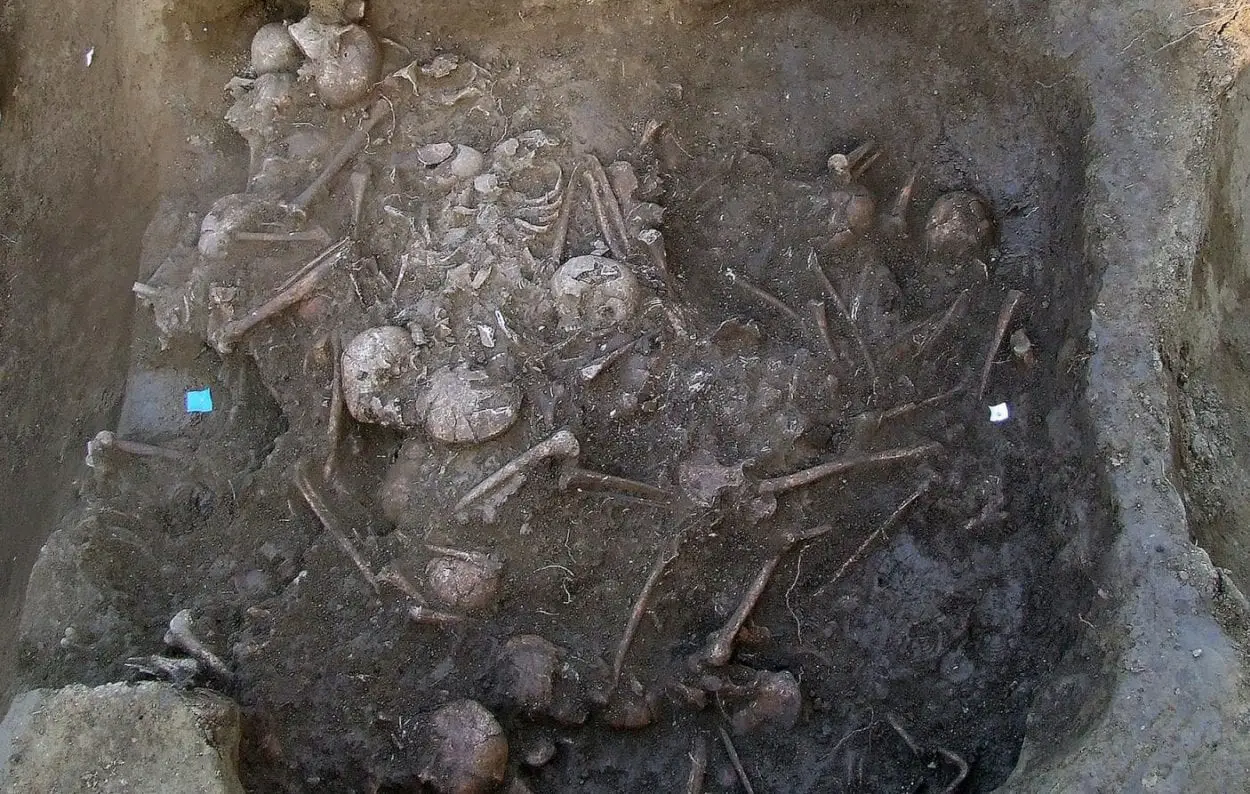In previous research, ancient massacre sites found men who died while pitted in battle or discovered executions of targeted families.
At other sites, evidence showed killing of members of a migrant community in conflict with previously established communities, and even murders of those who were part of religious rituals.
But a more recent discovery by a research team — that includes two University of Wyoming faculty members — reveals the oldest documented site of an indiscriminate mass killing 6,200 years ago in what is now Potocani, Croatia.
“The DNA, combined with the archaeological and skeletal evidence — especially that indicating systematic violence, perhaps even execution-style — demonstrates an indiscriminate massacre and haphazard burial of 41 individuals from an early pastoralist community in what is now eastern Croatia,” says James Ahern, a UW professor in the Department of Anthropology and associate vice provost for graduate education.
Ahern was a nonsenior co-author of a paper, titled, “Genome-Wide Analysis of Nearly All the Victims of a 6,200-Year-Old Massacre,” that was published March 10 in PLOS ONE. The journal accepts research in over 200 subject areas across science, engineering, medicine, and the related social sciences and humanities.
Mario Novak, a research associate with the Institute for Anthropological Research in Zagreb, Croatia, was the paper’s lead author. Ivor Jankovic, a UW adjunct professor of anthropology and assistant director of the Institute for Anthropological Research, also was a nonsenior co-author of the study.
Other researchers who contributed to the paper were from the Universitat Pompeu Fabra in Barcelona, Spain; Harvard University; Archaeological Museum in Zagreb, Croatia; University of Zagreb; University of Vienna; Broad Institute of Harvard and Massachusetts Institute of Technology; and the Howard Hughes Medical Institute at Harvard Medical School.
In 2007, the Croatian site underwent a “rescue” excavation that occurred when the burial was uncovered during the construction of a garage on private land, Ahern says. Archaeologists, led by Jacqueline Balen of the Archaeological Museum in Zagreb, working nearby on a cultural resource impact assessment related to the construction of a motorway, were called in to investigate.
In 2012, Ahern and Jankovic, then a research scientist at the Institute for Anthropological Research, were invited by the archaeologists in charge of Potocani discoveries to analyze the skeletal remains. The skeletal remains needed to be cleaned and inventoried, and basic analysis — such as estimation of age and sex, recording of preserved elements, and basic documentation of pathologies and trauma — was conducted by Jankovic, Ahern and Zrinka Premuzic, a Ph.D. student at the University of Zagreb.
“This is the oldest known case of indiscriminate, mass killing that we know of,” Ahern says. “In some ways, it goes against the conventional wisdom about early agriculturalists — the Neolithic and Eneolithic — who have long been thought to have lived in small villages or herding groups.
“The DNA evidence indicates just a few close relatives in such a large sample, meaning that, not only was the violence seemingly indiscriminate, it involved a subset of a much larger local population.”
Prior research shows that some early farmers lived in large settlements, such as at Catalhoyuk in Western Asia; and some later Eneolithic peoples, such as those who lived at the Vucedol site in the Balkans. However, Potocani is approximately 1,000 years older than the latter settlement.
The genetic analysis revealed that 70 percent of the analyzed skeletons did not have close kin among the deceased. Additionally, there was no sex bias, as the number of males and females found at the site were almost equal in number. This indicates the massacre was not the outcome of inter-male fighting one would expect in battles, nor was the result of a reprisal event targeting individuals of a specific sex.
Cranial injuries were found on 13 of the 41 individuals massacred at the site, according to the study.
“Although we do not have evidence on the cause of death for the other individuals, their deaths were almost certainly violent,” Ahern says. “Multiple radiocarbon dates, as well as the sedimentology of the burial, all indicate a single burial event.
“Furthermore, a majority of violent deaths do not leave clear evidence of trauma in the preserved skeletal remains,” he continues. “Individuals could have been strangled, bludgeoned, cut or stabbed in soft-tissue areas or in manners that did not damage underlying bones.”
The study also considered the potential role of climate change in the mass burial event. When climate changes, resources such as water, vegetation — including feed for cattle and other livestock — and game animals become less predictable. Furthermore, hazards, such as unpredictable extreme weather, become more common.
“These factors tend to disrupt human lifeways, and groups sometimes try to take over others’ territories and resources,” Ahern explains. “Increases in population size cause groups to overextend their local resources and require expansion into other areas. Both climate change and population increase tend to cause social disruption and violent acts, such as what happened at Potocani, that become more common as groups come into conflict with each other.”
Data in the study reveal how organized violence in this period could be indiscriminate, just as indiscriminate killings have been an important feature of life in historic and modern times. The history, development and causes of human violence are crucial to our ability to understand and reduce violence in our own society, Ahern says.
“Perhaps, because of the long history of human violence and warfare and its contemporary relevance, the public is engaged by the sort of narrative about the deep human past that we’ve been able to recreate through our scientific research,” Ahern says. “Furthermore, DNA, heredity and human ancestry are issues that touch everyone’s lives. Our research also highlights UW’s global engagement and research enterprise.”
Header Image Credit : .Jacqueline Balen, Archaeological Museum of Zagreb





